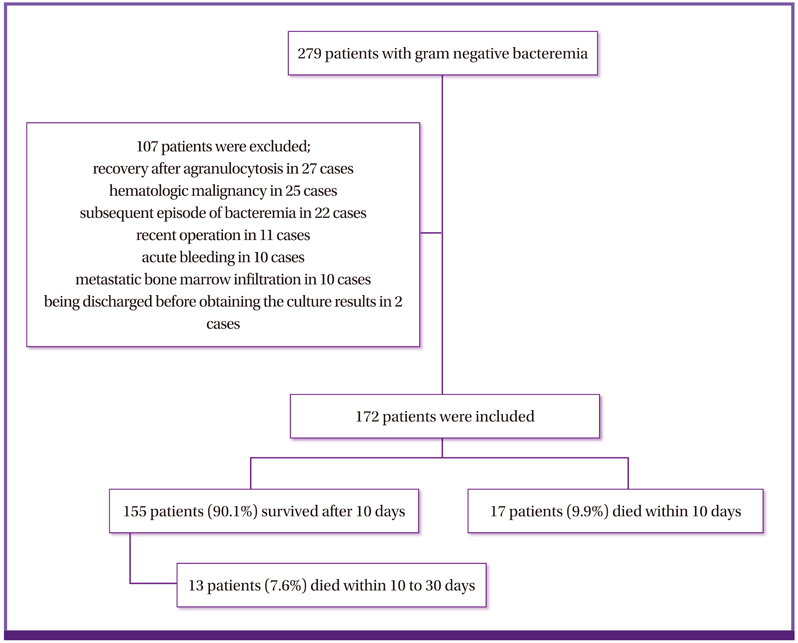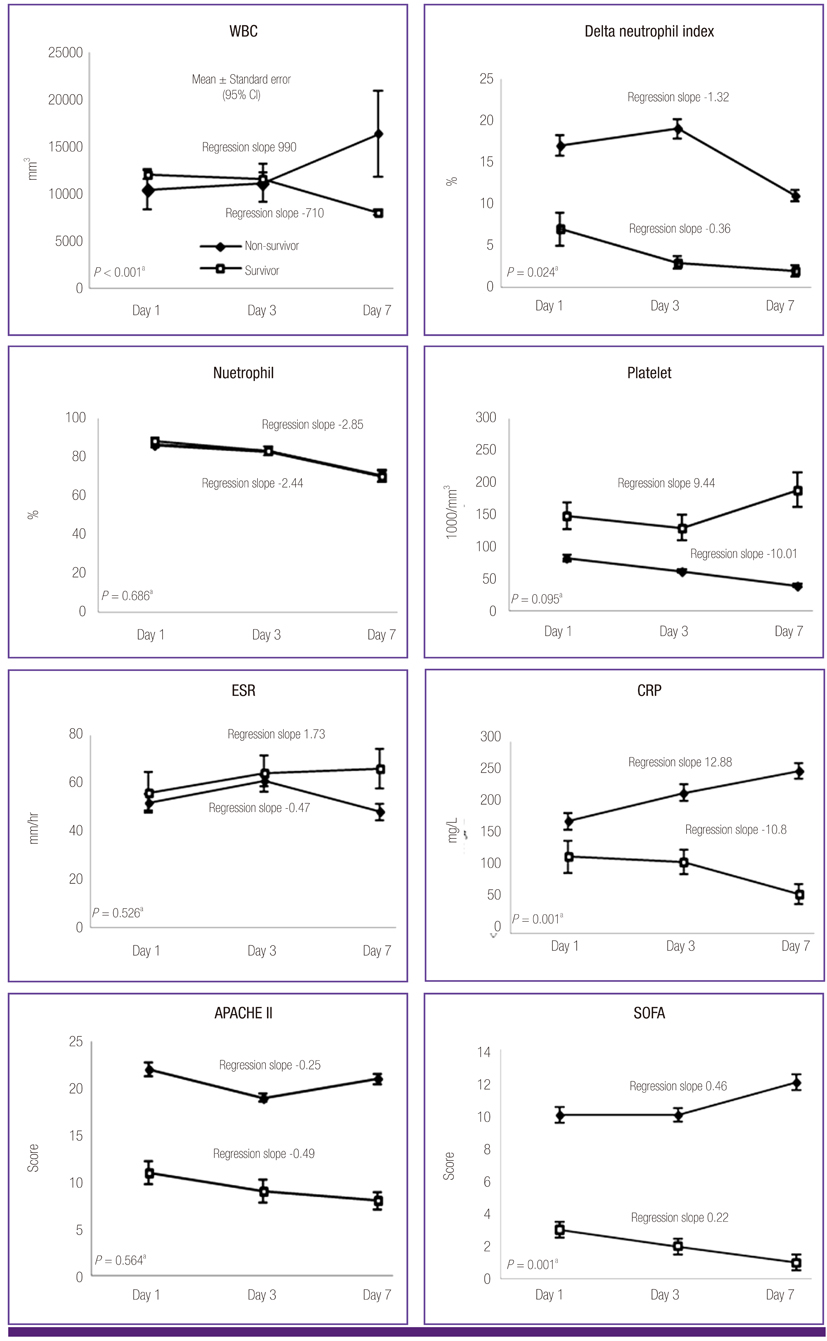Infect Chemother.
2014 Jun;46(2):94-102. 10.3947/ic.2014.46.2.94.
Delta Neutrophil Index as a Prognostic Marker of Early Mortality in Gram Negative Bacteremia
- Affiliations
-
- 1Department of Internal Medicine and AIDS Research Institutes, Yonsei University College of Medicine, Seoul, Korea. imfell@yuhs.ac
- KMID: 2284985
- DOI: http://doi.org/10.3947/ic.2014.46.2.94
Abstract
- BACKGROUND
Sepsis is a syndrome that results in high morbidity and mortality. We investigated the delta neutrophil index (DN) as a predictive marker of early mortality in patients with gram-negative bacteremia.
MATERIALS AND METHODS
We conducted a retrospective study at a tertiary referral hospital in South Korea from November 2010 to March 2011. The DN was measured at onset of bacteremia and 24 hours and 72 hours later. The DN was calculated using an automatic hematology analyzer. Factors associated with 10-day mortality were assessed using logistic regression.
RESULTS
A total of 172 patients with gram-negative bacteremia were included in the analysis; of these, 17 patients died within 10 days of bacteremia onset. In multivariate analysis, Sequental organ failure assessment scores (odds ratio [OR]: 2.24, 95% confidence interval [CI]: 1.31 to 3.84; P = 0.003), DN-day 1 > or = 7.6% (OR: 305.18, 95% CI: 1.73 to 53983.52; P = 0.030) and DN-day 3 > or = DN-day 1 (OR: 77.77, 95% CI: 1.90 to 3188.05; P = 0.022) were independent factors associated with early mortality in gram-negative bacteremia. Of four multivariate models developed and tested using various factors, the model using both DN-day 1 > or = 7.6% and DN-day 3 > or = DN-day 1 was most predictive early mortality.
CONCLUSIONS
DN may be a useful marker of early mortality in patients with gram-negative bacteremia. We found both DN-day 1 and DN trend to be significantly associated with early mortality.
MeSH Terms
Figure
Cited by 2 articles
-
Diagnostic Significance of the Delta Neutrophil Index and Other Conventional Parameters in Neonatal Bacteremia
Il Doo Koh, Ihn Soo Jeon, Hwang Min Kim
Pediatr Infect Vaccine. 2017;24(1):1-6. doi: 10.14776/piv.2017.24.1.1.Predictors and outcomes of sepsis-induced cardiomyopathy in critically ill patients
Myung Jin Song, Sang Hoon Lee, Ah Young Leem, Song Yee Kim, Kyung Soo Chung, Eun Young Kim, Ji Ye Jung, Young Ae Kang, Young Sam Kim, Joon Chang, Moo Suk Park
Acute Crit Care. 2020;35(2):67-76. doi: 10.4266/acc.2020.00024.
Reference
-
1. Levy MM, Dellinger RP, Townsend SR, Linde-Zwirble WT, Marshall JC, Bion J, Schorr C, Artigas A, Ramsay G, Beale R, Parker MM, Gerlach H, Reinhart K, Silva E, Harvey M, Regan S, Angus DC. Surviving Sepsis Campaign. The Surviving Sepsis Campaign: results of an international guideline-based performance improvement program targeting severe sepsis. Crit Care Med. 2010; 38:367–374.
Article2. Huttunen R, Aittoniemi J. New concepts in the pathogenesis, diagnosis and treatment of bacteremia and sepsis. J Infect. 2011; 63:407–419.
Article3. Dickinson JD, Kollef MH. Early and adequate antibiotic therapy in the treatment of severe sepsis and septic shock. Curr Infect Dis Rep. 2011; 13:399–405.
Article4. Andaluz-Ojeda D, Bobillo F, Iglesias V, Almansa R, Rico L, Gandía F, Resino S, Tamayo E, de Lejarazu RO, Bermejo-Martin JF. A combined score of pro- and anti-inflammatory interleukins improves mortality prediction in severe sepsis. Cytokine. 2012; 57:332–336.
Article5. Marshall JC, Reinhart K. International Sepsis Forum. Biomarkers of sepsis. Crit Care Med. 2009; 37:2290–2298.
Article6. Pierrakos C, Vincent JL. Sepsis biomarkers: a review. Crit Care. 2010; 14:R15.
Article7. Nahm CH, Choi JW, Lee J. Delta neutrophil index in automated immature granulocyte counts for assessing disease severity of patients with sepsis. Ann Clin Lab Sci. 2008; 38:241–246.8. Park BH, Kang YA, Park MS, Jung WJ, Lee SH, Lee SK, Kim SY, Kim SK, Chang J, Jung JY, Kim YS. Delta neutrophil index as an early marker of disease severity in critically ill patients with sepsis. BMC Infect Dis. 2011; 11:299.
Article9. Fujimoto H, Sakata T, Hamaguchi Y, Shiga S, Tohyama K, Ichiyama S, Wang FS, Houwen B. Flow cytometric method for enumeration and classification of reactive immature granulocyte populations. Cytometry. 2000; 42:371–378.
Article10. Levy MM, Fink MP, Marshall JC, Abraham E, Angus D, Cook D, Cohen J, Opal SM, Vincent JL, Ramsay G. SCCM/ESICM/ACCP/ATS/SIS. 2001 SCCM/ESICM/ACCP/ATS/SIS international sepsis definitions conference. Crit Care Med. 2003; 31:1250–1256.
Article11. Seok Y, Choi JR, Kim J, Kim YK, Lee J, Song J, Kim SJ, Lee KA. Delta neutrophil index (DN): a promising diagnostic and prognostic marker for sepsis. Shock. 2012; 37:242–246.12. Kim HW, Ku S, Jeong SJ, Jin SJ, Han SH, Choi JY, Kim JM, Song YG. Delta neutrophil index: could it predict mortality in patients with bacteraemia? Scand J Infect Dis. 2012; 44:475–480.
Article13. Lee CH, Kim J, Park Y, Park YC, Kim Y, Yoon KJ, Uh Y, Lee KA. Delta neutrophil index discriminates true bacteremia from blood culture contamination. Clin Chim Acta. 2014; 427:11–14.
Article14. Lee SM, Eun HS, Namgung R, Park MS, Park KI, Lee C. Usefulness of the delta neutrophil index for assessing neonatal sepsis. Acta Paediatr. 2013; 102:e13–e16.
Article15. Lim TS, Kim BK, Lee JW, Lee YK, Chang S, Kim SU, Kim DY, Ahn SH, Han KH, Chon CY, Park JY. Use of the delta neutrophil index as a prognostic factor of mortality in patients with spontaneous bacterial peritonitis: implications of a simple and useful marker. PLoS One. 2014; 9:e86884.
Article16. Charlson M, Szatrowski TP, Peterson J, Gold J. Validation of a combined comorbidity index. J Clin Epidemiol. 1994; 47:1245–1251.
Article17. Knaus WA, Draper EA, Wagner DP, Zimmerman JE. APACHE II: a severity of disease classification system. Crit Care Med. 1985; 13:818–829.18. Ferreira FL, Bota DP, Bross A, Mélot C, Vincent JL. Serial evaluation of the SOFA score to predict outcome in critically ill patients. JAMA. 2001; 286:1754–1758.
Article19. Gogos CA, Lekkou A, Papageorgiou O, Siagris D, Skoutelis A, Bassaris HP. Clinical prognostic markers in patients with severe sepsis: a prospective analysis of 139 consecutive cases. J Infect. 2003; 47:300–306.
Article20. Ansari-Lari MA, Kickler TS, Borowitz MJ. Immature granulocyte measurement using the Sysmex XE-2100. Relationship to infection and sepsis. Am J Clin Pathol. 2003; 120:795–799.
Article21. Kang CI, Song JH, Chung DR, Peck KR, Ko KS, Yeom JS, Ki HK, Son JS, Lee SS, Kim YS, Jung SI, Kim SW, Chang HH, Ryu SY, Kwon KT, Lee H, Moon C. Korean Network for Study of Infectious Diseases (KONSID). Risk factors and pathogenic significance of severe sepsis and septic shock in 2286 patients with gram-negative bacteremia. J Infect. 2011; 62:26–33.
Article22. Laupland KB, Gregson DB, Church DL, Ross T, Pitout JD. Incidence, risk factors and outcomes of Escherichia coli bloodstream infections in a large Canadian region. Clin Microbiol Infect. 2008; 14:1041–1047.
Article23. Nigro KG, O'Riordan M, Molloy EJ, Walsh MC, Sandhaus LM. Performance of an automated immature granulocyte count as a predictor of neonatal sepsis. Am J Clin Pathol. 2005; 123:618–624.
Article24. Bernstein LH, Rucinski J. Measurement of granulocyte maturation may improve the early diagnosis of the septic state. Clin Chem Lab Med. 2011; 49:2089–2095.
Article
- Full Text Links
- Actions
-
Cited
- CITED
-
- Close
- Share
- Similar articles
-
- Delta Neutrophil Index as an Early Marker of Sepsis in Burn Patients
- Does delta neutrophil index predict 30-day mortality in patients admitted tointensive care unit via emergency department?
- Delta Neutrophil Index as a Prognostic Marker in the Pediatric Intensive Care Unit
- Assessment of Perforation of Acute Appendicitis using the Delta Neutrophil Index Reflecting Peripheral Immature Granulocyte Count
- Delta Neutrophil Index as an Early Marker for Differential Diagnosis of Adult-Onset Still's Disease and Sepsis




